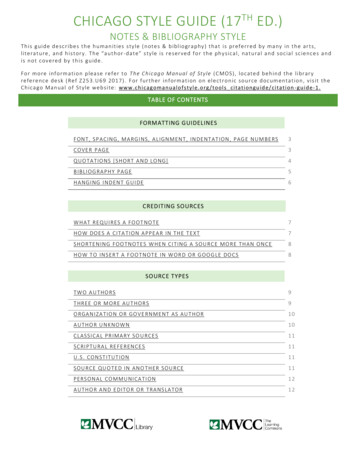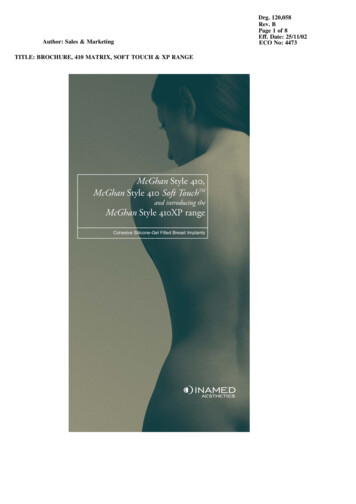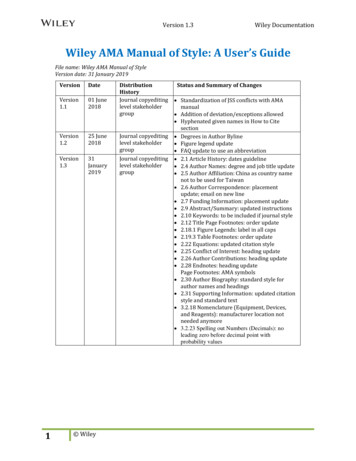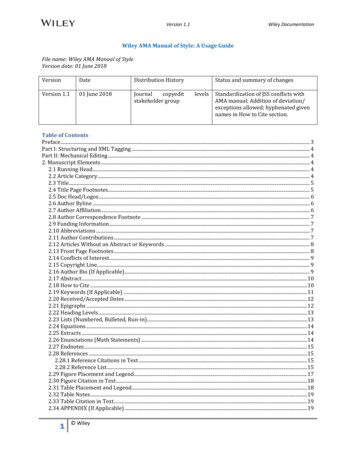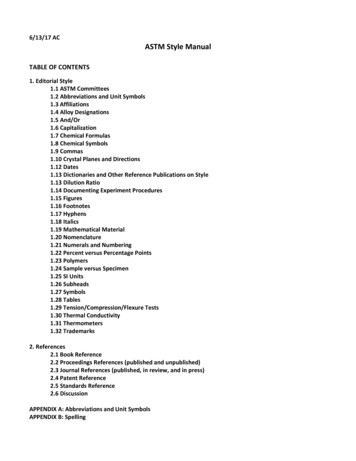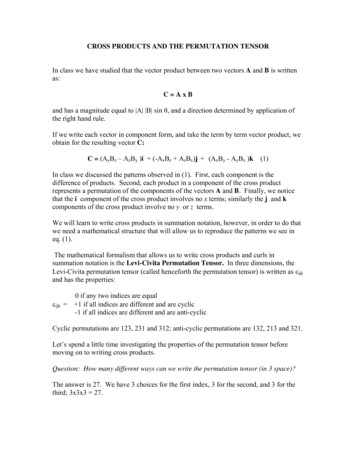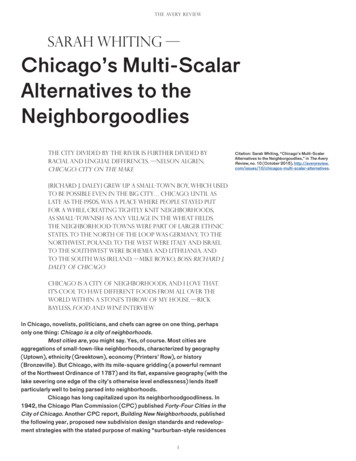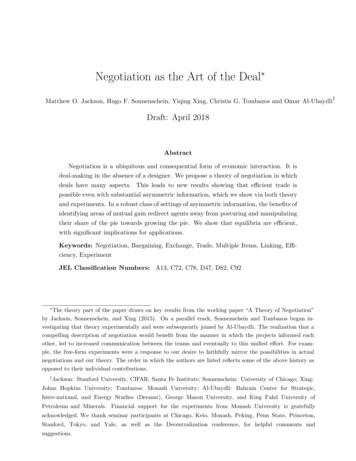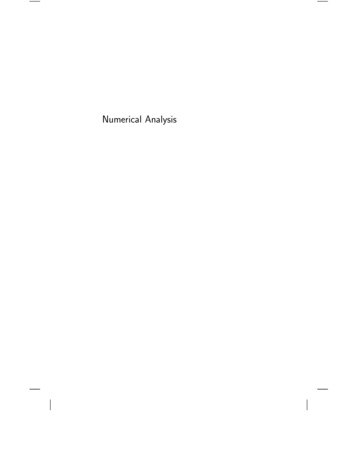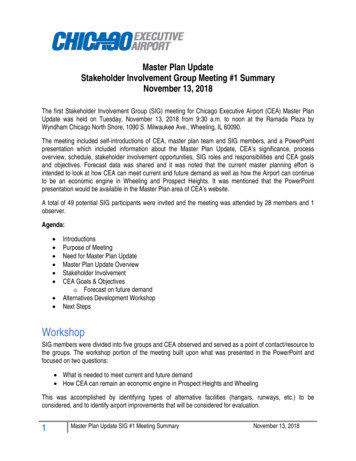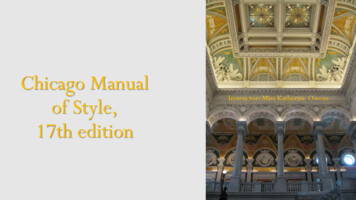
Transcription
Chicago Manualof Style,17th editionInstructor: Miss Katherine Owens
Creating Citations Why should you have citations?oTo avoid plagiarismoShowing where you got ideas from/ providingacknowledgementoProves that you did scholarly work and did not makeeverything upoSo you can have a starting point if you write on the sametopic again later in timeoThe teacher can read what sources you used if they wantmore detailed knowledge of the topic
Chapter 1: Books and Journals Because Chicago is gearedtowards the author ratherthan the college student, thereis no real section on what toinclude on the title page of apaper. 1.19-1.35 discuss the parts ofthe title and verso pages ofbooks. TitleSubtitleAuthor’s nameDate Professor’s name Course name and number Other information yourprofessor indicates
Chapter 2: Manuscript Preparation . 2.8 Line spacing 2.12 Paragraph format 2.9 Space between sentences orafter colons 2.18 Format for SubheadsoDouble space lineso Single space betweensentences 2.10 Justification and marginsoLeft-hand justify, not fulljustifiedo No blank line betweenparagraphsoFlush left, and type fontshould not be different fromnormal text (font, size, bold,etc.)
Chapter 2: Manuscript Preparation . 2.28-2.29 Numbering 2.54 Choosing a Dictionary illustrations/Numbering tablesoWebster’s Third Newo Types of illustrations,graphic, or tables shouldhave separate numberingsystemsInternational Dictionary(REF PE1625. W36 1981) orMerriam-Webster’sCollegiate Dictionary (onlinereference book throughCredo)
Chapter 4: Copyright In the academic setting, seeking copyright permission from theauthor/owner of the copyright is not necessary as long as thepaper is properly cited. Should you have a chance to present your work in public orattempt to publish your paper, please consult chapter 4 andyour professor to find out if you will need to seek any copyrightpermissions.
Chapter 6: Punctuation 6.9 Periods and commas inrelation to closing quotationsmarkso Periods and commas go insideending quotes, even if not in thequoted material,.” or ,” 6.10 Colons, semicolons, questionmarks, and exclamation pointso All the above go outside closingquotes UNLESS part of thequotation,”! Or ”? Or ”: or ”; 6.18 Commas relative toparentheses and brackets; 6.98Parentheses with otherpunctuationoCommas, semicolons, andcolons are not needed beforeparentheses; always putoutside the endingparenthetical.
Chapter 6: Punctuation 6.95 Use of parentheses; 6.99Use of square brackets 6.123 Abbreviation-endingperiods with other punctuationo Parentheses can be used tooIf an abbreviating wordenclose related materialends a sentence, the period(to the sentence) but notfor the abbreviation alsoessential to the sentence,doubles as the period.while square bracketsusually denote anaddition of informationwithin a quote. Quotation marks withinquotation marks are handledin ch. 13.
Chapter 7: Spelling, Distinctive Treatment ofWords, and Compounds 7.6 Alternative pluralso If the dictionary you use (Webster being preferred) provides two ways to plural aword, Chicago opts for the first. 7.30 Contractionso Nothing fancy or unusual about these in Chicagoo (Just remember, they are not acceptable in an academic paper) 7.50-7.52; 7.56-7.58 Mechanical emphasiso DO NOT emphasize a word via italics, bold, underline, Capitalization, or withquotes either ‘single’ or “double.”o Phrases in a foreign language, i.e., not used as an English word/saying (c’est lavie/la dolce vita/gesundheit/semper fidelis/buenas noches), should be italicizedand then defined.
Chapter 13: Quotations and Dialogue 13.4 When to paraphrase ratherthan quoteoExcessive quotations are adistractionoThey also indicate a poorwriter or someone unable tothink for themselvesoParaphrase all but the mostimportant quotes 13.5 When quotation andattribution is unnecessaryoCommon knowledge or“readily verifiable facts” do notneed citationsoNot listed, but important is thatwhether you direct quote orparaphrase information from anoutside source, you mustprovide a citation, with theexception of above exception.
Chapter 13: Quotations and Dialogue 13.7 Permissible changes to punctuation, capitalization, and spellingo Quotations marks should be changed to fit your formatting.o En dashes or hyphens may be changed to an em dash.o In a direct quotation the first letter of the first word may be capitalized orlower-cased depending on position in your sentence.o At the end of a direct quotation, the original punctuation may be changed.o Source citations in the original may be deleted, or if included, the materialshould be block quoted with the original source information in a smallertype font at the end of the block quote.o Typographical errors may be corrected, unless part of the original writingstyle or archaic spelling.o The old-fashioned ſ, v, or j may be replaced with the modern curvatures: s,u, and i.
Chapter 13: Quotations and Dialogue 13.10 Choosing between run-in andblock quotationso The rule says to create a block quotefor a direct quotation that is 100words or more (6-7 lines)o At Flagler College, quotations equalto more than 3 lines (abt 50 words) isturned into a block quote. 13.30 Quotations and “quoteswithin quotes”o Jefferson said, “We have a problem.I do share the famous man’ssentiment ‘I cannot live withoutbooks ’ So do not quote me assaying: ‘Jimmy Jefferson claimedthe famous man’s sentiment, “Icannot live without books ,” doesnot represent his point-of-view.’” 13.59 Missing or illegible wordso “In reproducing or quoting from adocument in which certain wordsare missing or illegible, an authormay use ellipses , a bracketedcomment or guess ”o “A 2-em dash , sometimes incombination with an interpolatedguess, may also be used formissing material.”o At Flagler College, only the firstoption is acceptable! See theexample to the left.
Chapter 14: Notes and Bibliography 14.12 Access dates 14.24 Numbers in text versuso Chicago does not require access dates for numbers in notesmost electronic resourceso At Flagler, all sources accessedelectronically must have an access date. 14.19 Notes and bibliography– an overviewo This section says that you can use eitherjust footnotes for your sources, or ashortened citation and a bibliography.o At Flagler, the first footnote for a sourceis full-length, and shortened thereafter.Bibliographies are not an option, but arequirement.o In the text, the fn no. is asuperscript, and in the fn/ensection, it is the same size as thecitation followed by a period.o At Flagler, periods are notnecessary. 14.26 Placement of numbero You place the number either afterthe period of a sentence (includingquotes, or parenthesis). The onlyexception is if the informationinside a parenthesis is the citedinformation, then the fn goes inside.
Chapter 14: Notes and Bibliography 14.34 Shortened citations versus“ibid.”o“In a departure from previouseditions, Chicago discouragesthe use of ibid. in favor ofshortened citations as describedelsewhere in this section; toavoid repetition, the title of awork just cited may be omitted.Shortened citations generallytake up less than a line, meaningthat ibid. saves no space, and inelectronic formats that link toone note at a time, ibid. risksconfusing the reader.” 14.37 Citations Plus CommentaryoIf you include a note withinyour note, write out thecitation and after the period a space, write your furthercommentary. 14.57 Several citations in one noteoThis is of course permissible,however, be sure to put asemicolon between eachcitationoThe citations should be in thesame order as the materialbeing cited/referenced
Chapter 14: Notes and Bibliography 14.63 Dividing a bibliographyinto sectionsoHelpful for some classes isthe option to divide yoursources by type. You willstart each new listing witha header “PrimarySources,” or “ArchivalMaterials,” etc., and thenalphabetize as normal. 14.64 Kinds of BibliographiesoRead this section for adescription of: Full BibliographySelected BibliographyAnnotated BibliographyBibliographic EssayList of Works by OneAuthor
Creating CitationsWhat do you need in order to cite?BookWebsiteJournal ArticleAuthorAuthorAuthor (if provided)TitleTitle of ArticleWebpage TitlePlace of PublicationTitle of JournalWebsite TitlePublication HouseVolume NumberDate (if provided)DateIssue NumberURLURL or DOIDateDate You Viewed the PageFormat (for non-print/ non-electroniccopies)Page NumbersURL or DOIDate You Viewed the article (sometimes)
Parts to a BookSeries TitleAuthorTitleEditor &IntroductionacknowledgementPlace of PublicationDatePublishing House
Writing CitationsBibliographic Entry:Gaskell, Elizabeth. North and South. Oxford: Oxford University Press, 1998.Reference Entry:Gaskell, Elizabeth. 1998. North and South. Oxford: Oxford University Press.
Parts to a Journal ArticleJournal TitleVol.#Article TitleDateAuthorIssue#Page #
Writing CitationsBibliographic Entry:Rieger, Bernhard. “From People’s Car to New Beetle: The Transatlantic Journeys of theVolkswagen Beetle.” Journal of American History 97, no. 1 (June 2010): 91-115.Reference Entry:Rieger, Bernhard. 2010. “From People’s Car to New Beetle: The Transatlantic Journeys ofthe Volkswagen Beetle.” Journal of American History 97, no. 1 (June 2010): 91-115.
Writing CitationsBibliographic Entry:National Museum of Natural History, Arctic Studies Center. “Vikings: The NorthAtlantic Saga.” Smithsonian: National Museum of Natural History. Accessed July 16,2010. http://www.mnh.si.edu/vikings/home.html.Reference Entry:National Museum of Natural History, Arctic Studies Center. n.d. “Vikings: The NorthAtlantic Saga.” Smithsonian: National Museum of Natural History. Accessed July 16,2010. http://www.mnh.si.edu/vikings/home.html.
Footnotes
Footnotes
Footnotes
2.54 Choosing a Dictionary oWebster’s Third New International Dictionary (REF PE1625. W36 1981) or Merriam-Webster’s Collegiate Dictionary (online reference book through Credo)

